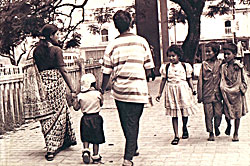 |
Originally published by an American academic publisher in 2003, this anthropological study was intended as a case study of the formation of a modern middle class in a peripheral region of the world. The new edition, with a more affordable price tag than the ones normally affixed to volumes produced by Western publishers, is targeted at the English-speaking Kathmandu middle class, the class that forms the subject of the book. It offers them self-recognition and an understanding of how they have been shaped by the demands of the new consumer economy of transnational goods and media.
A middle-class culture began to develop in Kathmandu only after the demise of the Rana regime in 1951. Over the next half-century all the old restrictions were demolished and Nepal was flung open to an array of international influences, ranging from foreign aid, tourism, print and electronic mass media and English language education. The beginnings of a modern economy created new avenues of professional and earning opportunity. These gave rise to a new social group defined more by their middle-class status than by caste or ethnicity, with values increasingly defined more by a global capitalist consumer culture than by traditional norms.
Liechty shows how the advent of a modern material culture can be a profoundly disorienting experience for a large section of the middle class. Accustomed to a society where status is largely dependent on heredity, members of the middle class find themselves in a culture where status increasingly depends on access to consumer goods (ranging from private education to tv sets).
 |
In the struggle to maintain balance, the middle class creates stories about the suitability and respectability of its class position. It perceives itself as superior both to the lower classes-identified by their ignorance and blind adherence to tradition-as well as to the upper classes-identified as having lost all traditional notions of decency by having succumbed totally to the vulgarities of a Western consumer culture.
Liechty's observations are based on more than 200 interviews he conducted with a wide variety of members of Kathmandu's middle class in the early and mid-1990s. His questions focus chiefly on their self-perception and the meanings they assign to the clothing, films, music and other goods they consume. Extended quotes from these interviews are frequently interspersed throughout the text.
There is a certain nostalgic pleasure to be derived from specific references from that era-the culture of video parlors, the music show Sunday Pop on Nepal that was so popular before the advent of satellite tv, and slang that has now become outmoded. However, the relentless cataloguing of near-identical responses sometimes causes tedium. The
extended academic discussions on the nature and meaning of class are also not likely to inspire much interest in a generalist audience.
But on the occasions that Liechty offers sustained life-histories of particular individuals, the writing transcends the merely academic. Particularly moving are his stories of two educated young men of limited financial and social resources who find themselves caught in a nowhere place between tradition and modernity. One of them is a drug addict, the other unemployed. Both of them feel that their education has uprooted them but has not provided them with any sustainable alternative. Through detailing the chasm between their real and imagined lives, Liechty viscerally evokes the anxiety and fear this discrepancy provokes.


